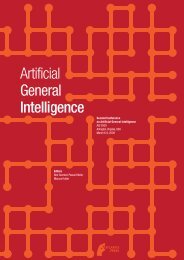Algorithmic Learning Theory - of Marcus Hutter
Algorithmic Learning Theory - of Marcus Hutter
Algorithmic Learning Theory - of Marcus Hutter
You also want an ePaper? Increase the reach of your titles
YUMPU automatically turns print PDFs into web optimized ePapers that Google loves.
Editors’ Introduction 7<br />
Lev Reyzin and Nikhil Srivastava study various problems <strong>of</strong> learning and verifying<br />
properties <strong>of</strong> hidden graphs given query access to the graphs. This setting<br />
lends itself naturally to a range <strong>of</strong> query types that are somewhat different from<br />
those described above; these include edge detection, edge counting, and shortest<br />
path queries. Reyzin and Srivastava give bounds on learning and verifying general<br />
graphs, degree-bounded graphs, and trees with these types <strong>of</strong> queries. These<br />
results extend our understanding <strong>of</strong> what these types <strong>of</strong> queries can accomplish.<br />
Rika Okada, Satoshi Matsumoto, Tomoyuki Uchida, Yusuke Suzuki and Takayoshi<br />
Shoudai study learnability <strong>of</strong> finite unions <strong>of</strong> linear graph patterns from<br />
equivalence queries and subset queries. These types <strong>of</strong> graph patterns are useful<br />
for data mining from semi-structured data. The authors show that positive<br />
results can be achieved for learning from equivalence and subset queries (with<br />
counterexamples), and give negative results for learning from restricted subset<br />
queries (in which no counterexamples are given).<br />
Kernel-Based <strong>Learning</strong>. A kernel function is a mapping which, given two<br />
inputs, implicitly represents each input as a vector in some (possibly highdimensional<br />
or infinite dimensional) feature space and outputs the inner product<br />
between these two vectors. Kernel methods have received much attention in recent<br />
years in part because it is <strong>of</strong>ten possible to compute the value <strong>of</strong> the kernel<br />
function much more efficiently than would be possible by performing an explicit<br />
representation <strong>of</strong> the input as a vector in feature space. Kernel functions play a<br />
crucial role in Support Vector Machines and have a rich theory as well as many<br />
uses in practical systems.<br />
Developing new kernel functions, and selecting the most appropriate kernels<br />
for particular learning tasks, is an active area <strong>of</strong> research. One difficulty in constructing<br />
kernel functions is in ensuring that they obey the condition <strong>of</strong> positive<br />
semidefiniteness. Kilho Shin and Tetsuji Kuboyama give a sufficient condition<br />
under which it is ensured that new candidate kernels constructed in a particular<br />
way from known positive semidefinite kernels will themselves be positive semidefinite<br />
and hence will indeed be legitimate kernel functions. Their work gives new<br />
insights into several kernel functions that have been studied recently such as<br />
principal-angle kernels, determinant kernels, and codon-improved kernels.<br />
Guillaume Stempfel and Liva Ralaivola study how kernels can be used to<br />
learn data separable in the feature space except for the presence <strong>of</strong> random<br />
classification noise. They describe an algorithm which combines kernel methods,<br />
random projections, and known noise tolerant approaches for learning linear<br />
separators over finite dimensional feature spaces, and give a PAC style analysis<br />
<strong>of</strong> the algorithm. Given noisy data which is such that the noise-free version would<br />
be linearly separable with a suitable margin in the implicit feature space, their<br />
approach yields an efficient algorithm for learning even if the implicit feature<br />
space has infinitely many dimensions.<br />
Adam Kowalczyk’s paper deals with analyzing hypothesis classes that consist<br />
<strong>of</strong> linear functionals superimposed with “smooth” feature maps; these are<br />
the types <strong>of</strong> hypotheses generated by many kernel methods. The paper studies<br />
continuity <strong>of</strong> two important performance metrics, namely the error rate and













